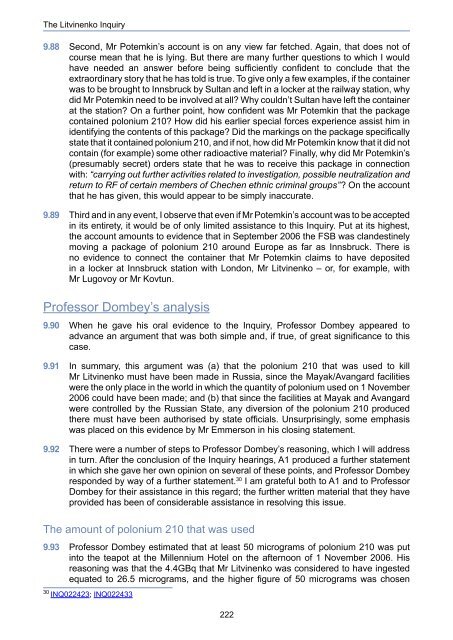The Litvinenko Inquiry
JIEp7Zyr
JIEp7Zyr
Create successful ePaper yourself
Turn your PDF publications into a flip-book with our unique Google optimized e-Paper software.
<strong>The</strong> <strong>Litvinenko</strong> <strong>Inquiry</strong><br />
9.88 Second, Mr Potemkin’s account is on any view far fetched. Again, that does not of<br />
course mean that he is lying. But there are many further questions to which I would<br />
have needed an answer before being sufficiently confident to conclude that the<br />
extraordinary story that he has told is true. To give only a few examples, if the container<br />
was to be brought to Innsbruck by Sultan and left in a locker at the railway station, why<br />
did Mr Potemkin need to be involved at all? Why couldn’t Sultan have left the container<br />
at the station? On a further point, how confident was Mr Potemkin that the package<br />
contained polonium 210? How did his earlier special forces experience assist him in<br />
identifying the contents of this package? Did the markings on the package specifically<br />
state that it contained polonium 210, and if not, how did Mr Potemkin know that it did not<br />
contain (for example) some other radioactive material? Finally, why did Mr Potemkin’s<br />
(presumably secret) orders state that he was to receive this package in connection<br />
with: “carrying out further activities related to investigation, possible neutralization and<br />
return to RF of certain members of Chechen ethnic criminal groups” ? On the account<br />
that he has given, this would appear to be simply inaccurate.<br />
9.89 Third and in any event, I observe that even if Mr Potemkin’s account was to be accepted<br />
in its entirety, it would be of only limited assistance to this <strong>Inquiry</strong>. Put at its highest,<br />
the account amounts to evidence that in September 2006 the FSB was clandestinely<br />
moving a package of polonium 210 around Europe as far as Innsbruck. <strong>The</strong>re is<br />
no evidence to connect the container that Mr Potemkin claims to have deposited<br />
in a locker at Innsbruck station with London, Mr <strong>Litvinenko</strong> – or, for example, with<br />
Mr Lugovoy or Mr Kovtun.<br />
Professor Dombey’s analysis<br />
9.90 When he gave his oral evidence to the <strong>Inquiry</strong>, Professor Dombey appeared to<br />
advance an argument that was both simple and, if true, of great significance to this<br />
case.<br />
9.91 In summary, this argument was (a) that the polonium 210 that was used to kill<br />
Mr <strong>Litvinenko</strong> must have been made in Russia, since the Mayak/Avangard facilities<br />
were the only place in the world in which the quantity of polonium used on 1 November<br />
2006 could have been made; and (b) that since the facilities at Mayak and Avangard<br />
were controlled by the Russian State, any diversion of the polonium 210 produced<br />
there must have been authorised by state officials. Unsurprisingly, some emphasis<br />
was placed on this evidence by Mr Emmerson in his closing statement.<br />
9.92 <strong>The</strong>re were a number of steps to Professor Dombey’s reasoning, which I will address<br />
in turn. After the conclusion of the <strong>Inquiry</strong> hearings, A1 produced a further statement<br />
in which she gave her own opinion on several of these points, and Professor Dombey<br />
responded by way of a further statement. 30 I am grateful both to A1 and to Professor<br />
Dombey for their assistance in this regard; the further written material that they have<br />
provided has been of considerable assistance in resolving this issue.<br />
<strong>The</strong> amount of polonium 210 that was used<br />
9.93 Professor Dombey estimated that at least 50 micrograms of polonium 210 was put<br />
into the teapot at the Millennium Hotel on the afternoon of 1 November 2006. His<br />
reasoning was that the 4.4GBq that Mr <strong>Litvinenko</strong> was considered to have ingested<br />
equated to 26.5 micrograms, and the higher figure of 50 micrograms was chosen<br />
30<br />
INQ022423; INQ022433<br />
222


